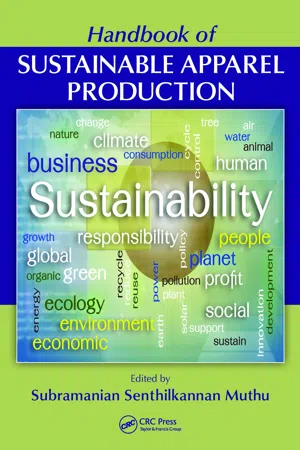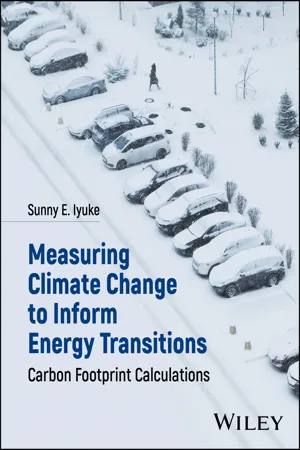Technology & Engineering
Carbon Footprint of Materials
The carbon footprint of materials refers to the total amount of greenhouse gases emitted during the production, transportation, and disposal of a material. It is a measure of the environmental impact of a material, taking into account its entire lifecycle. Understanding the carbon footprint of materials is important for making sustainable choices in engineering and technology.
Written by Perlego with AI-assistance
Related key terms
1 of 5
6 Key excerpts on "Carbon Footprint of Materials"
- eBook - PDF
- Subramanian Senthilkannan Muthu(Author)
- 2015(Publication Date)
- CRC Press(Publisher)
7.3 CARBON FOOTPRINT Carbon footprint is the term used to evaluate the total emission of GHGs by human activities. Few other terms are also used to quantify the emission of GHG and slightly vary in their method of mea-surement and system of representation. The following section gives the definition of different terms that are regularly used in the field of carbon footprint. 7.3.1 D EFINITION OF C ARBON F OOTPRINT AND O THER R ELATED P ARAMETERS 7.3.1.1 Global Warming Potential Global warming potential (GWP) is a relative measure of how much heat a GHG traps in the atmo-sphere to contribute toward global warming and compares the amount of heat trapped by a certain mass of the gas under study to the amount of heat trapped by a similar mass of CO 2 . This system of representation may be useful when we evaluate the condition of nature over a long period of time. GWP is the relative effect of climate change over a certain period of time. For example, for 20 years of duration, it can be represented as GWP 20 and for 100 years, GWP 100 . 9 7.3.1.2 Carbon Footprint Carbon footprint is the measurement of the amount of GHG produced through burning of fossil fuels for electricity, heating, transportation, etc., and it is expressed in terms of tons or 1990 0 200 400 600 800 2000 2004 2005 2006 Year 2007 2008 2009 Methane Nitrous oxide High-GWP gases Emission of green house gases (in million metric tons) FIGURE 7.4 Year-wise emission of GHG in the United States. (From U.S. Census Bureau, Statistical abstract of the United States: 2012, pp. 221–242.) 146 Handbook of Sustainable Apparel Production kilogram or gram CO 2 equivalent. 9 It can be calculated in terms of GWP using the following equation: 9 Climate change = ∑ i GWP a , i × m i (7.1) where GWP a , i is the GWP for the substance i integrated over a specified number of years m i (kg) is the quantity of substance i emitted The result is expressed in kilogram or tons of the reference substance, CO 2 . - Jiri J Klemes, Jiří Jaromír Klemeš(Authors)
- 2015(Publication Date)
- Butterworth-Heinemann(Publisher)
It illustrates the global life cycle-wide material extraction and the final consumption of material within a region, occurring either within a country or beyond borders of countries (Giljum et al., 2013a). Material footprint is a newer term for “ecological rucksacks” (Giljum et al., 2013a). Another definition of material footprint is that it is an indicator for measuring and optimizing the resource consumption of products and their ingredients and the production processes along the whole value chain (Lettenmeier et al., 2012). Emission footprint The emission footprint represents the quantities of product or service-created emissions into the air (e.g., SO 2, particles, CO, CO 2), water (e.g., chemical oxygen demand (COD), nitrogen, and phosphorus), and soil (through spillage in the soil). Emission footprints are calculated on a per-area basis. The conversion of emissions is calculated according to the principle that anthropogenic mass flows must not alter the qualities of local compartments. Maximum flows are defined based on the naturally existing qualities of the compartments and their replenishment rate per unit area. For emissions to soil, the replenishment rate is given by the decomposition of biomass to humus (measured by the production of compost by biomass). For groundwater, this is the seepage rate (given by local precipitation). For emissions into the air, the natural exchange of substances between forests and air per unit area is taken as a basis of comparison between natural and anthropogenic flows. Different emissions to air are not weighted, because only the largest dissipation areas are to be considered- eBook - PDF
Measuring Climate Change to Inform Energy Transitions
Carbon Footprint Calculations
- Sunny E. Iyuke(Author)
- 2024(Publication Date)
- Wiley(Publisher)
1 1 Introduction, Carbon Footprint and Climate Change 1.1 Introduction A carbon footprint can be defined as the measure of the impact of human activities have on the environment due to direct or indirect release of greenhouse gases. It estimates the greenhouse gases in pounds or tons of carbon dioxide (CO 2 ). Within the context of total Ecological Footprint, the tonnes of carbon dioxide emissions are expressed as the amount of productive land area required to sequester those carbon dioxide emissions. This refers to biocapacity that is necessary to neutralise the emissions from burning fossil fuels. Thus, measuring the carbon footprint in land area shows how much biocapacity is needed to take care of untreated carbon waste and avoid a carbon build-up in the atmosphere. This method of measurement allows addressing climate change challenge in a holistic manner that does not simply shift the burden from one natural system to another because the planet does not provide enough biocapacity to neutralise all the carbon dioxide from fossil fuel and other-natural CO 2 sequestration medium. Levels of CO 2 in the atmosphere are moderately normal, because it helps to keep the planet warm and plays an integral role in many key biological processes, which includes photosynthesis and other biogenic transformations by nature. These earthly transformations produce the so-called Global Carbon Cycle. However, human activities have altered this natural cycle by adding more concentration of CO 2 to the atmosphere, which has overburdened natural ability to remove it. The major culprit in the increased CO 2 concentrations in the atmosphere is the burning of fossil fuels (oil, coal and natural gas), as well as changes in land use from deforestation. The ocean is not left out in sustaining the stability of the carbon cycle by absorbing excess CO 2 from the atmosphere. - eBook - PDF
- Subramanian Senthilkannan Muthu(Author)
- 2015(Publication Date)
- CRC Press(Publisher)
148 The Carbon Footprint Handbook 7.6.1 A CTIVITY -R ELATED S YSTEM B OUNDARIES Key activity-related life-cycle system boundary issues are connected to production, operation, and end-of-life stages of buildings (Figure 7.3). 7.6.1.1 Production Stage Energy is expended during the production stage of buildings for a range of activities including acquisition of raw materials, transport and processing of raw materials into building materials, and fabrication and assembly of materials into a ready building. GHGs may be emitted from fossil-fuel combustion, land-use practices, and industrial process reactions when undertaking these activi-ties. Biomass residues are produced during the production stage of wood-based product systems, for example, from forest thinning and harvesting, wood-processing industries, and construction sites. Accounting of carbon footprint of wood-based products needs to consider the flow of residues from the wood product chain (Schlamadinger et al. 1997). An appropriate system boundary for carbon footprint analysis for non-biological materials, for example, mineral ores, may be from the point of extraction. In the case of cultivated bio-based material such as sustainably produced wood, the system boundary needs to be defined to encompass the technological (i.e., human-directed) energy used for biomass production. This includes the GHG flows from fuels used for the manage-ment of forest land, the harvesting of timber, and the transport and processing of wood materials (Gustavsson and Sathre 2011). CO 2 flows which occur during cement reaction need to be considered when modeling carbon footprint of cement-based products. Calcination emissions result from a chemical reaction that con-verts heated limestone (CaCO 3 ) to calcium oxide (CaO) and CO 2 , during cement manufacture. - Arshad Ahmed, John Sturges(Authors)
- 2014(Publication Date)
- Routledge(Publisher)
all of the outputs, and it is these waste outputs that can cause so many environmental problems. If we are not to modify the Earth’s ecosystems to the point where they will no longer support human life, there are certain limits or boundaries that we must not exceed. Lynas (2011) has indicated what these boundaries or limits might be, and he identifies nine in all. These are: climate change (carbon emissions), biodiversity, nitrogen, land use, fresh water, toxic emissions, aerosols, ocean acidification and ozone. The extraction and use of materials has impacts in most of these areas.However, not all of the materials of construction will have equally large environmental effects; Allwood and Cullen (2012) point out that just five materials are responsible for 55 per cent of all industrial emissions. These materials are steel, cement, plastic, paper and aluminium, and all of them are utilised in building construction.22.6 Indices of environmental impactIf we are to precisely measure the extent of environmental impact of the manufacture of building materials, we need to take account of all the various types of impact that we have identified so far. In Section 22.4 we identified various impacts, and indices have been developed by engineers and environmentalists for five of these impacts. We shall look at these five first; they evaluate the impact of energy consumption, emission of carbon dioxide, production of waste and spoil, assessing the footprint of the manufacturing plant and process, and water usage.22.6.1 Embodied energy
This index measures the amount of energy consumed in making a unit quantity of the required material (usually 1 kg or 1 tonne). It is given in the units of joules per kilogram or joules per tonne. It is not a measure of energy ‘contained’ within the material, but its value will depend upon the efficiency of the production plant. For example, during the Second World War it probably took 100 GJ of energy to produce a tonne of steel. In 2011, in a modern plant it will take no more than 22–23 GJ of energy to produce a tonne of steel.Units : GJ/tonne or MJ/kg.22.6.2 Embodied carbon dioxide
This index measures the emissions of CO2 in making a unit quantity of material. It is measured in terms of tonnes of CO2 emitted per tonne of product. CO2- Anne Gorman, Miriam Delaney(Authors)
- 2022(Publication Date)
- Laurence King Publishing(Publisher)
In terms of climate change ‘carbon’ is sometimes used as shorthand for carbon dioxide (CO 2), which is the most significant greenhouse gas released by human activity. It traps heat in the atmosphere close to the surface of the earth. Greenhouse effect A naturally occurring process whereby the atmosphere close to the earth acts to insulate it. High levels of CO 2 caused by human activity have increased the greenhouse effect, leading to rising temperatures. Fossil fuels Fuels derived from the decomposition of naturally occurring organisms. Gas, petroleum, oil, peat and coal are all fossil fuels. When burned, these finite resources release CO 2, which can increase the greenhouse effect. Carbon footprint The total amount of greenhouse gas emissions that come from the production, use and end-of-life of a human activity. In construction the carbon footprint is the measurement of the environmental impact of a building material, construction system or building. Life-cycle analysis (or life-cycle assessment) A methodology for assessing environmental impacts associated with all stages of the life cycle of a service, a product or an activity. It is sometimes called ‘cradle to grave’ analysis. Passive House (or Passiv-haus) An energy standard for buildings that are designed to significantly reduce their heating needs and energy demand, and so have a reduced ecological impact. It concerns the design, construction and running of buildings. Retrofit In construction retrofitting refers to the addition of new technologies or features to older buildings to reduce their environmental impact and minimize energy waste
Index pages curate the most relevant extracts from our library of academic textbooks. They’ve been created using an in-house natural language model (NLM), each adding context and meaning to key research topics.





